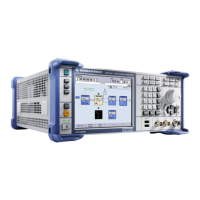Remote Control Basics
R&S
®
SMBV100A
425Operating Manual 1407.6062.32 ─ 08
●
STB, SRE
The STatus Byte (STB) register and its associated mask register Service Request
Enable (SRE) form the highest level of the status reporting system. The STB provides
a rough overview of the instrument status, collecting the information of the lower-level
registers.
●
ESR, SCPI registers
The STB receives its information from the following registers:
– The Event Status Register (ESR) with the associated mask register standard
Event Status Enable (ESE).
– The STATus:OPERation and STATus:QUEStionable registers which are
defined by SCPI and contain detailed information on the instrument.
●
IST, PPE
The IST flag ("Individual STatus"), like the SRQ, combines the entire instrument status
in a single bit. The PPE fulfills the same function for the IST flag as the SRE for the
service request.
●
Output buffer
The output buffer contains the messages the instrument returns to the controller. It
is not part of the status reporting system but determines the value of the MAV bit in
the STB and thus is represented in the overview.
All status registers have the same internal structure.
SRE, ESE
The service request enable register SRE can be used as ENABle part of the STB if the
STB is structured according to SCPI. By analogy, the ESE can be used as the ENABle
part of the ESR.
6.5.2 Structure of a SCPI Status Register
Each standard SCPI register consists of 5 parts. Each part has a width of 16 bits and has
different functions. The individual bits are independent of each other, i.e. each hardware
status is assigned a bit number which is valid for all five parts. Bit 15 (the most significant
bit) is set to zero for all parts. Thus the contents of the register parts can be processed
by the controller as positive integers.
Status Reporting System

